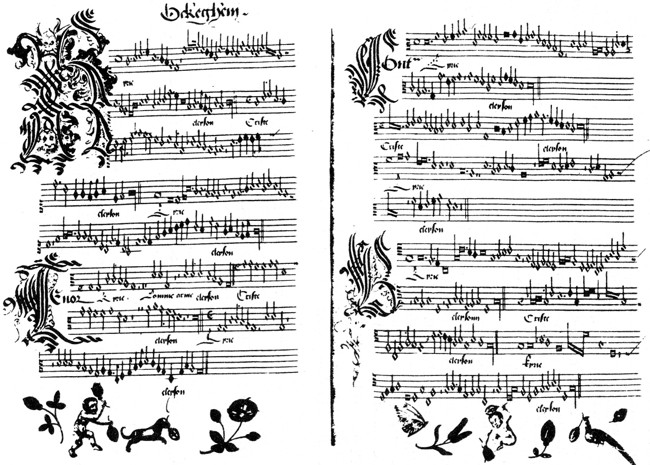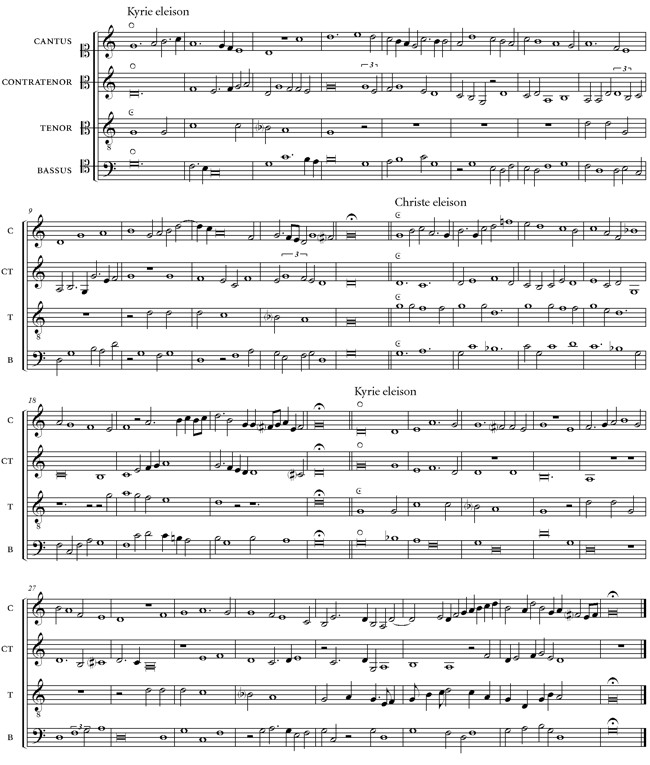
TSM | Cronologia | Onomastico | Glossario | Thesaurus
A melody used as the tenor of over 40 mass cycles between about 1450 and the end of the 17th century.
Those of Dufay, Ockeghem, Regis, Faugues and perhaps Busnoys seem to date from the 1450s. Those by Caron and Tinctoris as well as the cycle of six anonymous masses in a manuscript now in Naples (I-Nn, VI E 40) are probably from before about 1475. Those of Baziron (described as new in 1484), Obrecht, Josquin (2 settings), Brumel, Compère, Vaqueras, Gaffurius (lost) and De Orto are from the last quarter of the 15th century. Cycles from the early 16th century include those of Pipelare, Forestier, Venedier, La Rue (two settings), Carver and Senfl. Settings by Spanish composers of the 16th century include those of Peñalosa, Ortiz (lost), Morales (one for five voices printed in 1540 and one for four voices printed in 1544) and Guerrero (surviving in two versions). The two masses by Palestrina (for five voices printed in 1570 and for four voices printed in 1582) conclude the main series, though there was a later mass by Carissimi (12 voices), expanded with four more voices in later adaptations by Beretta and Stamegna. Particularly among the 30-odd masses before about 1510, there is clear evidence of composers having built upon, or emulated, other masses on the same tenor.
Although not among the greatest of these works, the cycle of six anonymous masses in Naples (ed. by L. Feininger, Monumenta Polyphoniae Liturgicae Sancta Ecclesiae Romanae, ser. 1/iii (1957), and ed. in CMM, lxxxv, 1981) merits attention as one of the most remarkable musical edifices of the 15th century. The first five masses take successive small sections of the melody, each treating it in various ways: the first uses only the first four notes; the second, and most intricate, of the series treats the next nine notes in retrograde, inversion and retrograde inversion. Those five masses are in four voices, while the last is in five voices and employs the entire melody in two of the voices in pure canon at the 5th throughout. The melody is always based on G, but the central tonalities of the six cycles are: C, G (with flat), F, G (without flat), G (with flat), C - as though following a coherent and planned tonal scheme. Each Kyrie has an elaborate trope, with heavy Classical references. Dispute continues as to whether they are all by one composer or by several working to a pre-arranged scheme, as might be deduced from differing stylistic features; but either way there is nothing remotely comparable from these years in either scope or formal ambition.
The melody and its text survive only in the Naples manuscript, though much of the material is endorsed by its use in a combinative chanson (perhaps of around 1463) perhaps by Robert Morton. Since no two masses contain precisely the same form of the melody, it is reasonable to assume that it had an unwritten origin and was monophonic. But its tripartite division makes it singularly well suited for use as the cantus firmus in a mass cycle. Other useful features include: the move into a higher register for the middle section coupled with the high A giving a sense of a different tonal centre; the leaps of a 4th and a 5th combined with falling lines at the ends of sections; and the motivic economy of the melody.
| tenor: L'homme armé doibt on doubter on a fait par tout crier – A l'assault – que chascun se viegne armer d'un haubregon de fer. ————— |
L'uomo in armi va fermato: d'ogni dove s'è gridato – All'assalto! – che ciascuno esca armato e di ferro corazzato. |
| rondeau: Il sera pour vous conbatu, le doubté turcq, maistre Symon. |
1] Da voi colpito, sia sottomesso il turco fiero, mastro Simone. |
| Certainement, ce sera mon et de crocq de arche abatu. |
2] Nessun avrà
altra opinione che a lui di spada starete addosso. |
| Son
orgueil tenons abatu, s'il chiet en voz mains, le felon. |
3]L'orgoglio suo
rimarrà scosso se in vostre mani cadrà il fellone. |
| Il sera etc. | 4]Da voi etc. |
| En
peu de heure l'arés batu, au plaisir Dieu, puis dira on: |
5] E poi passato tanto
sconquasso, Dio volendo, diran le persone: |
| Vive Symon et le Breton, que sur le turcq s'est enbatu. |
6] «Viva il Bretone,
viva Simone sul turco caduto come un masso». |
| Il sera etc. | 7] Da voi etc. |
| Certainement
etc. |
8] Nessun etc. |
 — Le pagine del codice Mellon
— Le pagine del codice Mellon — L'edizione moderna (Atlas 1981)
— L'edizione moderna (Atlas 1981)While many of the early settings (including those of Du Fay, Busnoys and Caron) have the melody on G with a flat signature, Ockeghem and others (including De Orto, Forestier and Palestrina's five-voice setting) have it in G without a flat. But all other tonalities were used: Regis, Faugues, Pipelare and Palestrina's four-voice setting have it on D; Obrecht, followed by Compère, have it on E, while Senfl similarly used the Phrygian mode but beginning on A. Josquin chose F for his mass sexti toni (followed in this only by Morales and Guerrero) and had it on all pitches of the hexachord, starting on C and progressing up to A, for his mass super voces musicales. C is otherwise found only in an anonymous eight-voice Credo in Copenhagen (DK-Kk 1872) and in the much later cycle of Carissimi (where it is always in the bass).
Elements of homage or emulation have been suggested, as in the transposition of the melody for particular movements (in the Credo of the masses by Ockeghem, Busnoys and Obrecht, for example), the use of retrograde and inversion, and so on. There was also apparent emulation in the use of elaborate canonic schemes, most particularly in the masses of La Rue and Forestier. Various theories have been advanced to explain the melody's astonishing career.
The appearance of musical sections in units of 31 has prompted the suggestion that many of the early masses were associated with the Burgundian ducal court's Order of the Golden Fleece, which had 31 knights (Taruskin). Two manuscripts of the Cappella Sistina (I-Rvat CS15 and CS35) containing groups of cycles have been connected with calls for a new crusade (Roth). The existence of a much earlier liturgy of the armed man commemorating the soldier Longinus who pierced Christ's side with a lance may also be relevant (Warmington). Moreover the song itself may have been for the mustering of soldiers, conceivably the French initiative of the late 1440s (Lockwood), or perhaps a reaction against this initiative (Chew); and it has been suggested that Ockeghem's mass could have been for the celebration of the end of the Hundred Years War, marked at Tours with a great ceremony on 10 March 1454 (Magro).
No single theory is likely to explain all the known masses, though many are probably the result simply of musical tradition (like the In Nomine settings in England). It is hard to think of any other melody in the history of music that has yielded so much music of the highest quality. Difficulties of dating 15th-century music have led to disputes about which setting was the earliest.
Du Fay, as the oldest composer, may seem the obvious choice, though dates proposed for his cycle range from the early 1450s to the late 1460s. Ockeghem's cycle is normally dated to the early 1450s, and its priority is asserted much later by Cerone (El melopeo, 1613, ii, 756). Busnoys' is the most widely distributed of the early masses and seems to be described as the earliest by Pietro Aaron (see Taruskin). Similarly there has been some discussion of a possible original polyphonic song. Cimello stated in about 1540 that Ockeghem wrote the original song (see Perkins), and Aaron seems to have ascribed it to Busnoys.
Neither of these is likely to be the combinative chanson Il sera pour vous conbatu/L'homme armé by Robert Morton, since its top-voice text almost certainly refers to events of 1463, well after the earliest masses. Perhaps there were earlier polyphonic song settings, since there were certainly later ones: the anonymous quodlibet with O rosa bella cited by Tinctoris and found incomplete in the manuscript E-E IV.a.24 (c1460); a quodlibet with D'ung aultre amer by Basiron; a quodlibet with Il est de bonne heure né by Japart; four-voice settings ascribed to Josquin and 'Falsum'.
Plainly the work therefore had a substantial career apart from the mass cycles. Its earlier success influenced several 20th-century composers to re-use it, among them J. N. David in his Fantasia super 'L'homme armé' for organ 1929, Helmut Eder, in L'homme armé: Konzert in drei Teïlen, op.50 (1969), Peter Maxwell Davies, who used the second mass of the 15th-Century Naples manuscript in his L'homme armé (1968) and his Missa super L'homme armé (1971), Louis Andriessen in De materie (1989) and Frederic Rzewski in his Piano Sonata (1991).
Pagina del Kyrie della messa L'homme armé dal Codice Chigi.

 – Immagine in grande.
– Immagine in grande. – Versione con le scansioni mensurali.
– Versione con le scansioni mensurali.